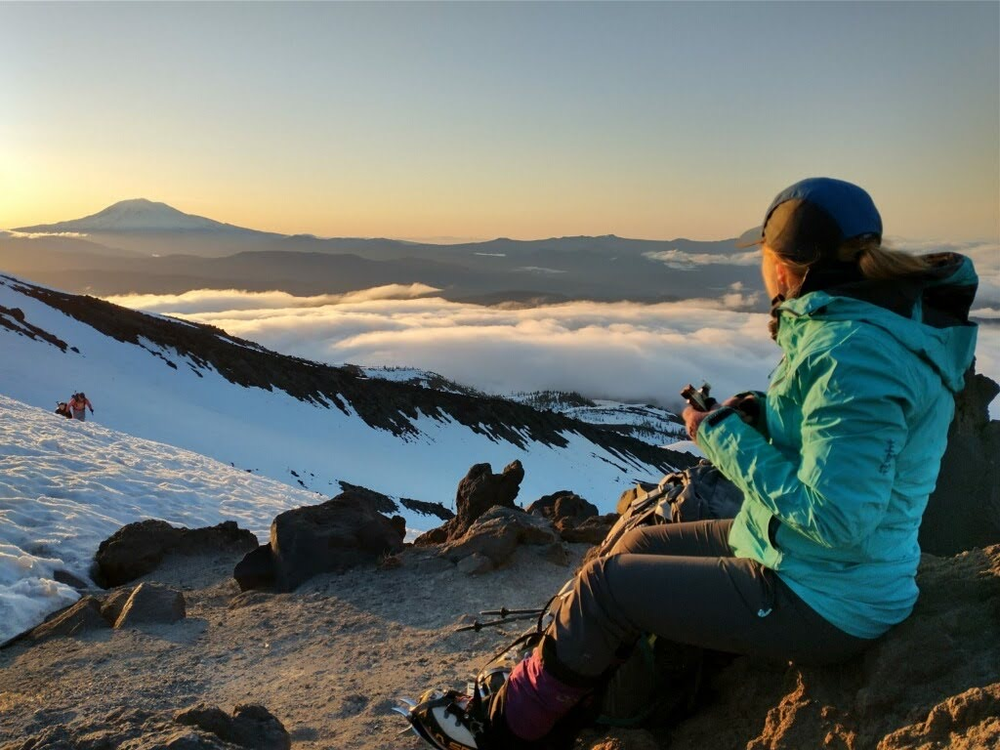
It was November 2018, and I was sobbing in my car at the Seattle Bouldering Project (SBP). David had just broken up with me. He was a skier, mountaineer, and climber I’d met six weeks prior. I’d fallen head over heels with both him and the rock climbing hobby he introduced me to.
As I stared at the steering wheel, tears blurring my vision, I felt shattered and confused. Why was I so devastated by the end of a relationship that lasted only six weeks and had more red flags than a circus tent? After all, he broke up with me because, as he said, winter was prime time for skiing and mountaineering, and he wouldn’t have time for dating. It did not take Shakespeare to see that this wasn’t a Romeo and Juliet situation.
Discouraged, I returned to running, the first sport I had fallen
in love with and the sport that had always brought me mental
clarity. With nothing but the percussive thwap of my sneakers
to distract me, I assessed my mess of feelings and finally came
to the realization that my devastation had little to do with David and far more to do with my loss of a gateway to the
world of outdoor adventure.
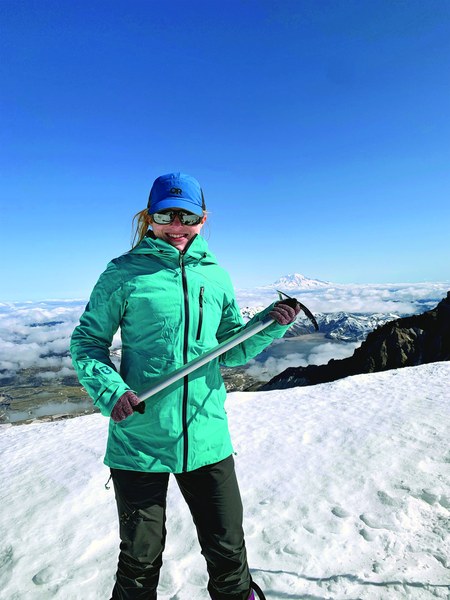 Christine at the summit of Mt. St. Helens. Photo by Andrew Lapinsky.
Christine at the summit of Mt. St. Helens. Photo by Andrew Lapinsky.
UNVEILING MY HERO’S JOURNEY
I have always been intrigued by hiking, mountaineering, and
climbing. I grew up ogling epic pictures of my dad — a talented
skier and mountaineer — soaring over snowy cliff faces in his
80s-era skis and listening to stories about him and his friends
summiting local mountains. (In one particularly notorious
story, his sleeping bag fell from his pack, ping-ponging into a
crevasse. He spent that cold night huddling with his climbing
partners for warmth in an unexpected white-out.)
My dad’s stories sparked an interest in adventure that was
further fanned by hours reading books about Hobbits, wizards,
and non-magical folks going on epic journeys. I, too, wished
I could go on a long, hard walk to save the world (if only
that’s all it took!). However, with no wizards arriving to guide
me, I contented myself with climbing trees in my backyard,
writing adventure stories on a clunky desktop computer, and
occasionally skiing and camping with my family.
You might wonder why I didn’t ask my parents to enroll me in outdoor or climbing programs. I saw myself as a shy, nerdy girl. And the shy, nerdy girls I saw on TV were not athletic. They did not go on adventures. They read books and had makeover montages. They certainly didn’t climb mountains or rock walls. I had seen so many stories about shy, nerdy girls that I started telling myself those same stories until I believed them. But somewhere buried underneath that fictional narrative was a little burning truth that I loved adventure and testing my limits.
Which brings me back to that SBP parking lot. In that moment,
crying over David, I unearthed my truth. I could no longer wait
for a guide to lead me on an adventure. I would need to do it
myself.
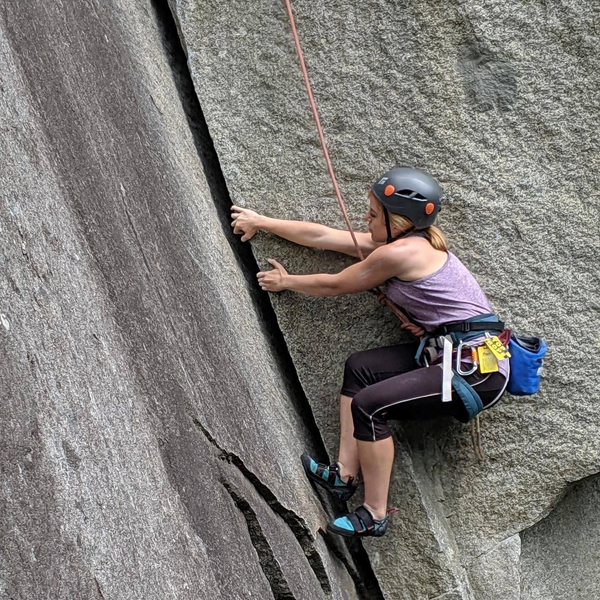 Christine climbing at Mt. Index. Photo by Andrew Lapinsky.
Christine climbing at Mt. Index. Photo by Andrew Lapinsky.
THE CALL TO ADVENTURE AS AN INDEPENDENT WOMAN
Feeling broken-hearted but emboldened, I embarked on
my solo journey into the outdoors. I booked snowshoe day
trips, and signed up for first aid, navigation, climbing, and
mountaineering classes. I researched nearby, well-trodden
hikes that I felt safe hiking as a solo female with limited
outdoor experience.
My first forays into solo adventuring were fraught with
nervousness. For one thing, I rarely did anything other than
running on my own. I had grown up, as many women do, with
the sense that being alone meant being vulnerable. With
nothing but the sound of my own thoughts for company, it
was easy to dwell on stories I had heard or just imagined about
women harassed or attacked on trails. My atrocious sense of
direction only increased my feelings of anxiety.
As I sat atop Mt. Si one December morning, gnawing a rock-hard granola bar that a Canadian Jay was beadily eyeing, I realized I was stronger and more capable than I had given myself credit. I had persevered through this hike and a growing number of challenging others, learning more about myself and hiking along the way (like how granola bars get rock-hard if you store them in the top of your pack during winter). Plus, I hadn’t gotten lost once.
To sum up, I had my nerdy girl makeover montage. But instead
of taking off my glasses and putting on a short skirt, I loaded
up on moisture-wicking base layers, waterproof pants, and a
newfound sense of confidence that had nothing to do with
how I looked to others and everything to do with embracing
a sense of self I had long denied. I didn’t need anyone else to
affirm my self-worth when I woke up early, drove to Mt. Si, and
cruised up the mountain before lunch, all in the revelry of my
own solitude.
FIGHTING FEARS AND FINDING FRIENDS
My confidence was further bolstered by confronting another
fear: socializing with strangers. I had always been shy and
quiet. However, I desperately wanted to find community in
the outdoors, particularly with other women. At the end of
each group class or excursion, I made it a goal to ask a fellow
woman on the trip if they’d like to hang out in the future, putting my once crippling sense of social anxiety to the side in the interest of greater female empowerment and connection.
I also rekindled old friendships with women who loved hiking
and climbing as much as I was growing to. One friend patiently
coached me as I attempted difficult climbs, suggesting
footholds or explaining techniques like stemming and heel
hooking. She cheered my successes and consoled me when
I became frustrated with a route, building my confidence all
the while.
I found a new sense of connection to my dad, too. We planned
hikes and ski trips together, and bonded over beautiful scenery,
chairlift rides, and the damp weather that was an inevitable
result of me discovering my love of the outdoors in late
November. He re-told stories of his youthful adventures, and
we realized that we shared more dreams than we previously
thought, or, in my case, admitted. He had also summited Mt.
Rainier, and I finally vocalized a childhood dream that I wanted to follow in my dad’s footsteps and make my own attempt at its summit.
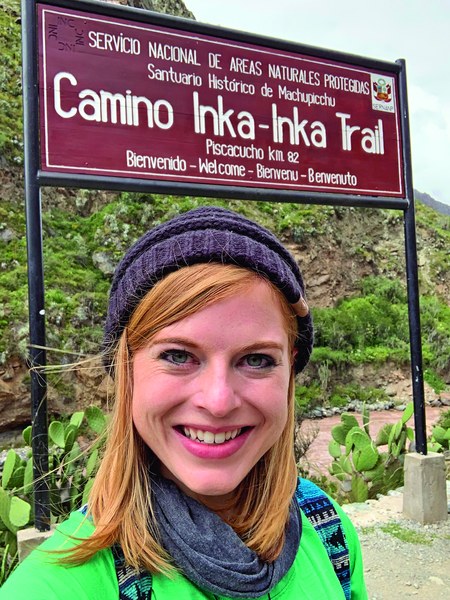 Christine hiking the trail to Machu Picchu. Photo by Christine Leibbrand.
Christine hiking the trail to Machu Picchu. Photo by Christine Leibbrand.
A DREAM A LIFETIME IN THE MAKING
It was the summer after that infamous breakup that my Mt.
Rainier dream started falling into place. I met Andrew — a
supportive and adventurous man who wasn’t intimidated by
the independence I had progressively built — and booked us
two spots on an expedition to summit Rainier in the summer
of 2020 (which would eventually get rescheduled due to COVID). I would finally, weather permitting, achieve the dream that I had quietly harbored since childhood.
I threw myself into training, developing a plan with hikes that
gradually increased in distance and elevation, tailored to the
season. Many of the early hikes I had soloed featured in my
trail plan and took on new meaning as I lumbered up them,
weighed down by a pack stuffed with sandbags and water bottles. My runs also took on new meaning as I incorporated
more hills, strengthening both my quads and tolerance for
discomfort.
More importantly, I loved the training process. While hiking
had quickly become a passion, making time for it felt
difficult. However, the Mt. Rainier trip forced me to make
hiking a priority. Every other Saturday I woke up at 5am and
arrived at the trailhead with the sunrise. Each hike offered
something new, even if I had done it before. One hike involved
an unexpected snowstorm that required some off-route
navigating I had learned in my classes. And after a rain-soaked
hike at Mt. Teneriffe, I cheered all I had learned about proper
weather-appropriate gear, having ended the hike feeling only
somewhat uncomfortable.
Everything was going great. I could carry a 40-pound pack
without much difficulty, despite being roughly the size of a
sixth grader. I summitted Mt. St. Helens on a gorgeous bluebird day, with plans to attempt Mt. Adams in early summer. Plus, I hit the unofficial benchmark of climbing Mt. Si in under 1.5 hours with a fully-loaded pack.
My climbing and running had also improved. After Mt. Rainier,
I planned to run my sixth marathon and was hoping to set a
personal record and qualify for the Boston Marathon.
MY LITERAL ACHILLES HEEL
I was feeling stronger than I ever had before, not just physically, but mentally as well.
Then, only two days after paying the non-refundable, full
amount for our Rainier trip, I tore my Achilles. I was trudging
up Mt. Si, hauling a 40-pound pack and attempting to heave
my diminutive, 5’ 1” body up a flight of steep steps when it
happened. It felt like someone had stabbed me. I continued
hiking, feeling confident that the pain was the result of
something lodged in my boot. But the pain only worsened.
The thought crossed my mind, “What if it’s my Achilles?” I had
always feared an Achilles injury more than anything. I knew it
meant a long recovery and a complete hiatus on all my favorite
activities, summitting Mt. Rainier certainly among them.
On the drive home, I inspected my heel. It looked okay,
although I wasn’t really sure what my heel looked like before.
Unlike my pores, I hadn’t scrutinized my heels on a daily basis so what was a normal heel supposed to look like? I rested for a couple days until I decided that the pain had been nothing
more than a skin irritation.
I walked to the local climbing gym, excited to be active
again. After attempting a tricky route, I fell off the wall and
felt a stabbing pain so intense I had to hobble off the mat.
Undeterred, I bandaged my heel and continued climbing. It
was while stemming the wall, my legs in an almost split, that
the pain became too unbearable to chalk up to a skin injury.
I walked home (another bad idea), booked an appointment
with a physical therapist, and within 24 hours found myself on
crutches, unable to walk a block without pain. The diagnosis
confirmed what I’d been trying to ignore.
Here comes another montage, one that’s a little more pathetic
and with Tom Petty’s “I Won’t Back Down” playing in the
background. I threw myself into physical therapy, got biweekly
acupuncture, foam rolled my calves until my shoulders seized,
consumed buckets of bone broth just in case it was the magic
bullet, and researched every possible therapy to get better
quickly, all in the hopes of being able to attempt the Rainier
summit. I didn’t back down until I had to.
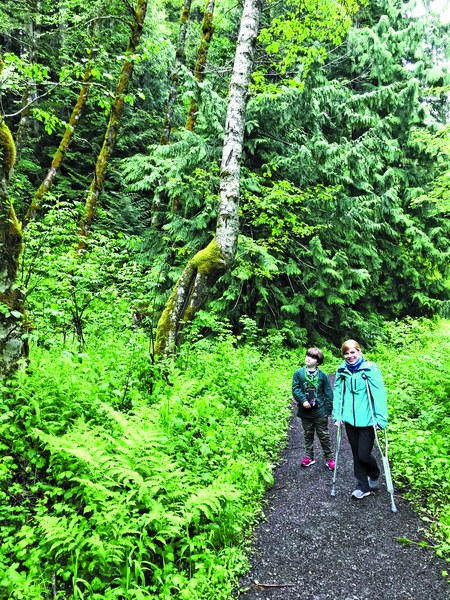 Christine hiking with her nephew and Dad after her Achilles injury. Photo by Brad Leibbrand.
Christine hiking with her nephew and Dad after her Achilles injury. Photo by Brad Leibbrand.
My own long, hard walk
The Rainier trip was three weeks away and I could walk five
blocks — five flat blocks. I had to accept that my nerdy-girl-turned-outdoor-adventurer story would not feature a Rainier summit. Crying harder than I did when David broke up with me, I emailed the mountaineering company and told them I was too injured to join the climb.
Three weeks later, I said goodbye to Andrew as he hauled his pack, ice axe, and hefty supply of gummy candies to the car. I did my best to be supportive and gracious, to see this as an AFGO (another f*cking growth opportunity), but I may have cried a lot when Andrew called me and relayed how everyone on the team was really nice, or when I crossed the 520 bridge and saw Mt. Rainier brazenly on display, or when I texted Andrew “good luck” and had to remind myself that I meant it.
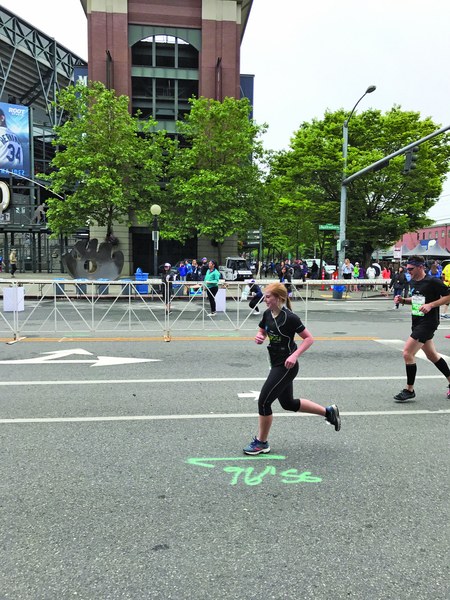 Christine running in the Seattle Rock and Roll Marathon in 2017. Photo by Brad Leibbrand.
Christine running in the Seattle Rock and Roll Marathon in 2017. Photo by Brad Leibbrand.
But then came a big moment for me. I was cleared by my
physical therapist to start running. It was only for a minute
at a time: one minute of running, one minute of walking,
alternated 10 times. However, it was still a milestone. I missed
hiking and climbing bitterly, but I was surprised to find that I
missed running the most. Running was my first love, the first
hobby that got me outdoors on my own, and the first that
showed me my strength.
I couldn’t summit Mt. Rainier, but those 10 minutes of running
showed me that I was summiting my own mountain. Yes, my
mountain only looked like the size of a very swollen Achilles
tendon, but it was comprised of all my fears of missing out and
of dreams unrealized. If I could run for 10 minutes when I could
barely walk five blocks the month before, I could summit Mt.
Rainier one day, or any other mountain for that matter.
The next day I got a text from Andrew. He had gotten altitude
sickness 1,200 feet from the summit at Disappointment
Cleaver and had to turn back. In that moment I knew I genuinely had been rooting for him and wanted him to summit. I was disappointed he didn’t get the outcome he wanted, but proud of both of us for giving it our all.
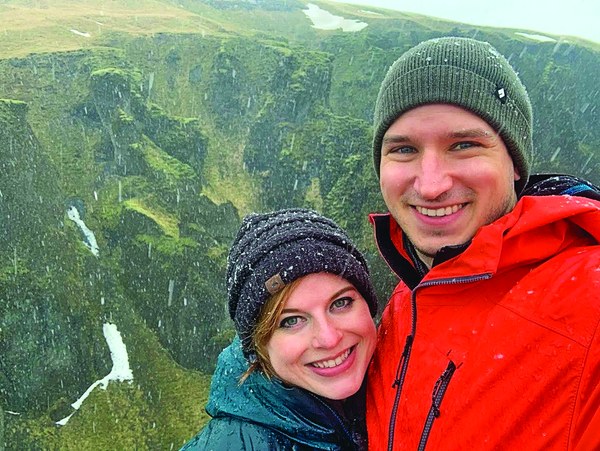 Christine and Andrew hiking in Iceland. Photo by Andrew Lapinsky.
Christine and Andrew hiking in Iceland. Photo by Andrew Lapinsky.
I might try to summit Mt. Rainier in the future, but I also might not. Sometimes dreams change and sometimes the pursuit of the dream is more important than the dream itself. It was the process of discovering my love for the outdoors, forging my own path, training for Mt. Rainier, and overcoming my injury that made me a stronger woman. I didn’t need a summit to prove how far I had come. While I don’t know if I’ll ever summit Mt. Rainier, I do know that I am forever grateful that years ago a boy broke up with me in a parking lot because that heartbreak took me on the greatest, most empowering adventure I ever could have imagined. So wherever you are, thank you David.
This article originally appeared in our fall 2023 issue of Mountaineer magazine. To view the original article in magazine form and read more stories from our publication, visit our magazine archive.
 Christine Leibbrand
Christine Leibbrand